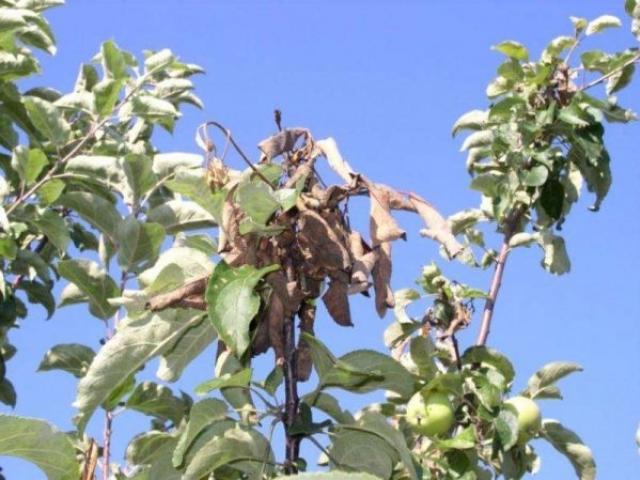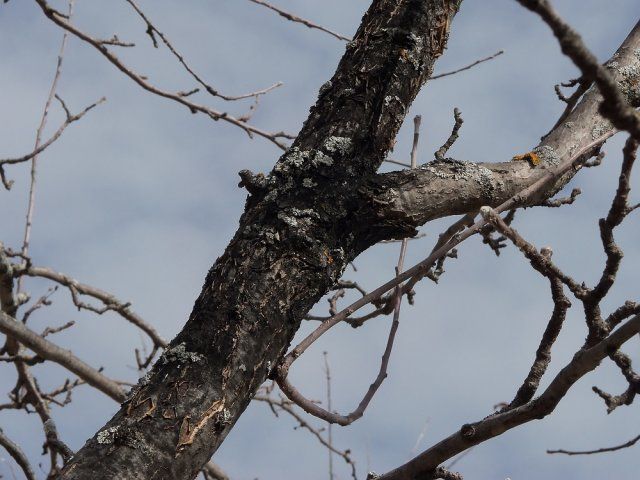Diseases of fruit trees, diseases of garden fruit trees
Content:
Fruit trees are a decoration of any garden or suburban area and, of course, the pride of a gardener. The culmination of efforts to care for them is a rich harvest. However, if you treat the plants on the site irresponsibly, without surrounding them with proper care, you can forget about ripe and healthy fruits. Like any living creature, a tree is susceptible to various kinds of diseases. Timely identification, treatment and elimination of the causes of the disease is the key to a blooming garden and a good harvest for many years.
Diseases of fruit trees
Diseases of trees can cause big trouble for the gardener. Two main groups can be distinguished:
- diseases caused by phytopathogenic fungi;
- diseases caused by bacteria;
Penetrating through damaged tree tissues or "stomata", which provide the tree with respiration, parasites cause significant damage to the plant, up to its death. In order to successfully fight a threat, you need to “know it by sight”. It will not be difficult for an experienced gardener to recognize diseases of fruit trees and choose the right treatment tactics.
The main fungal diseases of trees
The most significant danger to fruit crops is a fungal infection, which accounts for more than half of all plant diseases. Penetrating through the bark or damaged areas, the fungus actively grows, forming colonies that exist due to the absorption of organic matter from the host.
Milky shine
The main symptom is the silvery color of the leaves, which further leads to their drying out and withering away. First, the milky shine is localized on the south side, then spreads to the entire tree. If you take action in time, you can save both the tree and the crop.
Septoria
A disease predominantly affecting the pear. The onset of the disease is characterized by the appearance on the leaves of white rounded spots with a gray border. With the progression of the disease, brown dots - pycnidia appear inside the spots. Infection with this disease leads to drying and leaf fall.
Phylostictosis
One of the most unpleasant types of rust. The first sign is the accumulation of brown dots-pycnidia, and after drying, holes form in their place, which means that the plant is affected by this particular fungal disease. If urgent action is not taken, the tree will weaken and may die as a result.
Moniliosis
Signs of this infection are brown bloom, gray-brown blurred spots. This infection mainly affects new shoots and buds. Fruits affected by moniliosis have a characteristic smell of alcohol.
Powdery mildew
In case of damage by powdery mildew, a light bloom similar to dust appears on the leaves and young shoots, the leaves curl unnaturally, and the fruits acquire uncharacteristic pubescence.
Scab
The most common and dangerous fungal disease of fruit trees, especially apples and pears. Infection occurs through the kidneys and spreads over the entire surface of the tree.The disease can be recognized by a greenish-brown bloom spreading from leaves to fruits.
The diseased areas must be removed immediately and burned. Since the mushrooms have excellent vitality, do not fill compost pits with the removed material or put it on mulch. It is necessary to treat trees with fungicidal preparations, such as Teldor, Meloli DOU, Aliett, etc. The solution is prepared strictly according to the manufacturer's instructions. Processing is carried out at intervals of 15-30 days.
Diseases caused by bacterial infection
Bacteria are unicellular organisms, the nutrition of which, as in the case of fungi, occurs by parasitizing the tissues of fruit crops. Bacterial infections are no less dangerous for fruit trees and shrubs than fungal infections. Bacterial infection of fruit trees occurs through mechanical damage, for example, after pruning. The most susceptible to infections are fruit trees - apples, pears, plums, peaches, apricots.
Bacterial burn
It begins with the fact that the white exudate with a pungent odor, released as a result of the disease, quickly spreads in the form of a cobweb throughout the entire area. Inflorescences are affected first, and then leaves. The stage is considered neglected when, in addition to inflorescences, young shoots and bark are affected. It is characteristic that diseased inflorescences do not crumble and can remain on the tree throughout the season, and a burgundy "marble" pattern can be observed on the cuts of the bark.
Bark cracking in fruit trees
Why does the bark crack on fruit trees, and what treatment to choose - the questions that invariably arise for a gardener who finds a crack on the trunk of his favorite apple or pear. The causes of these phenomena are very diverse, but most often they are varieties of fruit cancer.
Black apple crayfish
The bacterium, getting into the damaged bark of a tree in the fall, remains under it throughout the winter. In the spring, you can find small black dots, indicating the presence of a destructive diagnosis. As the disease progresses, cracking and shedding of the bark, shedding of leaves before the fruit ripens, and in some cases mummification of the fruit can be observed. In especially difficult cases, the entire trunk is affected.
Cytosporosis
A disease that begins with damage to the bark of the trunk, spreading to the entire branch. Since the infected bark does not differ from the healthy one, it is extremely difficult to recognize the disease in the initial stage.
Common or European cancer
The main symptoms are brownish depressions with a light sheen on the trunk and branches. As the disease progresses, red bumps appear around the depressions - places where the spores of the fungus are concentrated. The terminal stage of infection of a tree by infection is the death of the bark and its separation in the form of circles with influxes along the edges.
Seedling bacterial cancer
All fruit crops and shrubs can get sick. The main symptom of this disease is the overgrowth of the tissues of the root or root collar.The progression of the disease stimulates the formation of growths, as a result of which the water supply of the tree is disrupted. Some of the roots die off. Rotting outgrowths leads to the fact that the soil becomes a source of infection, and therefore inevitably leads to its spread.
It is not possible to completely get rid of bacterial cancer of seedlings. However, it is quite possible to contain the spread of the infection. For this, medicinal preparations are used. Pruning trees should be carried out with the capture of healthy tissue at least 10 cm. Fresh cuts, in order to avoid re-infection, should be treated with garden varnish or putty. It is necessary to regularly treat gardening equipment with disinfectants, as bacteria can remain on it.
Having studied the features of the most common diseases of fruit trees, you will be able to recognize them in time and select the appropriate treatment. In some cases, this will help preserve the life of the plant, since it itself will not be able to cope with the disease.





















